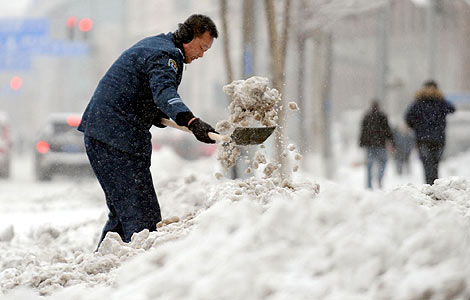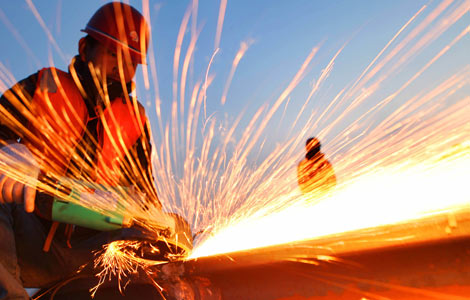
|
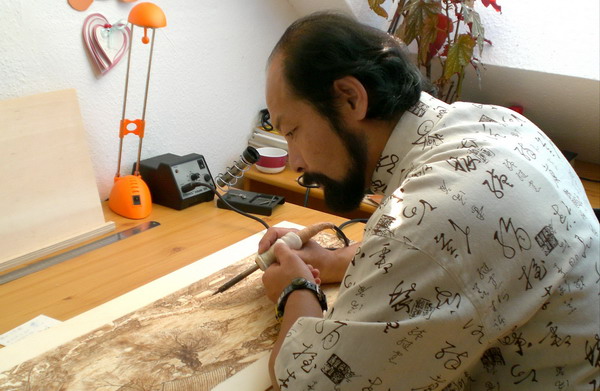 |
|
Zhang Yalian working on Riverside Scene at Qingming Festival
|
Nonetheless, in recent years, his pyrographs (a genre that uses a heated object as a brush to paint on various materials such as paper and wooden boards) have been exhibited in Hanau Germany, and are celebrated by many local people; some even go to his house to purchase his works.
Zhang produces pictures burnt onto boards by using various types of soldering irons.
The subjects of his creative pyrography are generally Chinese features, such as the twelve signs of the Chinese zodiac; Zhong Kui, a figure of Chinese mythology who is regarded as a vanquisher of ghosts and evil beings; and even the famous painting Riverside Scene at Qingming Festival which has been called “China's Mona Lisa”.
“The Germans are quite interested in traditional Chinese elements,” Zhang said.
Sometimes he adds a little color to embellish the pyrograph. "Westerners are intrigued by color. You know, colors are often very strong in Western paintings.”
Once, his wife’s colleagues visited their house and were thrilled by his art works. They bought some pieces, and the praise of his artworks travelled by word of mouth, until a prominent cultural institution in the area became aware of his works.
They found him and asked if he could give a month-long exhibition of his paintings in their exhibition hall every year before Christmas. "I think it is good to promote Chinese culture, so I said OK”.
At the first exhibition in 2007, he hung a series of paintings featuring the twelve creatures of the Chinese zodiac, with only the title of each painting attached. He found that the audience paid only cursory attention to the works, their hurried glances failing to catch the meaning of his paintings.
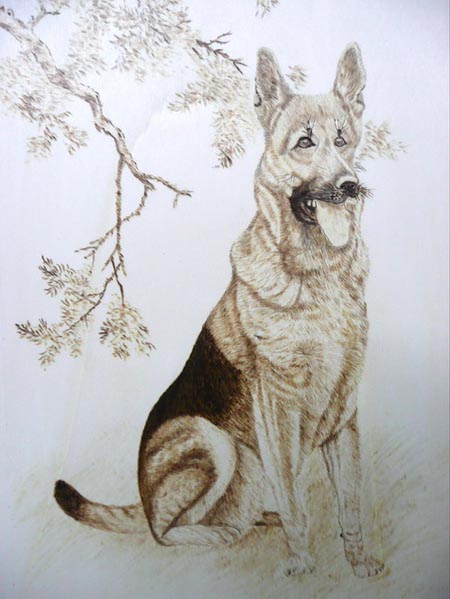 |
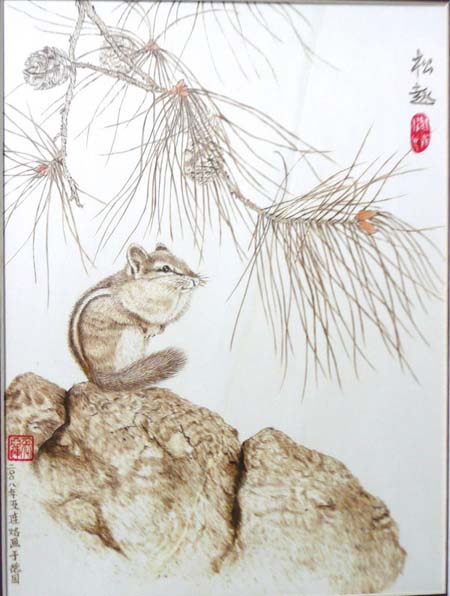 |
Below the painting of mouse, there was a small card that stated the years of the mouse, and their common character traits. Upon reading this information, the local visitors’ interests were stirred.
To date, he has held three exhibitions, each attached with introductory texts. After viewing the works, a lot of people decided on their favorite painting and went to his house to buy one of his works.
In Zhang’s eyes, it is difficult for German-based Chinese artists to promote their works in their local area. “We can’t compete with the local people by painting western works. Your works could stir the local interest only if you graduate from some local arts school or were taught by some local teacher. It is not very likely to organize a scalable exhibition for Chinese artists, since the Germans may not become interested in the Chinese works without fully understanding them.”
According to Zhang, many Chinese artists try to participate in the Sino-German cultural exchange exhibitions. Many of them have strong artistic aptitudes but become street entertainers to make a living. “They are in Germany, France, Italy, everywhere.”
Zhang thinks Chinese culture is not promoted enough abroad. “Quite a few Chinese exhibitions held overseas are mere formalities. Because you do not allow foreigners to truly understand the meaning of the paintings, you just let them think ‘Ah, this painting is beautiful!’ Their appreciation stays on the surface because they are not given the cultural knowledge to go deeper.”
He has noticed that the majority of Westerners lack a holistic understanding of Chinese culture. Years of cultural separation make it natural that the West view Eastern culture as mysterious. Zhang is confident though that if promoted well, Chinese art will enjoy more popularity in the West.
When it comes to helping Western audiences understand Chinese paintings, Zhang says the key is to explain details such as which angle is best to appreciate each painting, describing the mood of the painting, and illustrating how the painter produced it.
“Even if the explanation is very simple, it could help the audience with their understanding.”
Many people suggested that besides the exhibition Zhang could sell his works on eBay or at the flea market. "I told them that I do not paint for a living. This, coupled with my poor German, means I just play around with my art”.
As early as 1984, without knowing that pyrography existed, Zhang started “playing”. He began to work as a carpenter and once planned to make furniture for a friend who was getting married. The friend asked if he could make antique reproduction furniture, and Zhang suggested to burn some images into the wood.
Then he decorated every surface of the furniture with an electric iron, even the surface of each drawer. “It was nice. Since then, I have played with pyrography in my spare time.”
As well as several times spent in carpentry, Zhang used to do decorative design before going to Germany. He was also involved in film production with notable cinematographer Zhao Xiaoding. A man of many professions, Zhang even operated a tower crane and worked as a swimming coach before his migration.
In 2003, his wife went to work for the local medical college, thus the whole family moved to Hanau, Germany, near Frankfurt. Because of the language barrier, Zhang spent most of time taking care of the family and the dog. “I had plenty of time at home. You could call me ‘Zhai Nan’ (Indoors man).” He picked up pyrograph again.
Now his pyrographs are scattered all over the globe in Germany, the United States, Canada, and Sweden. He has sold or given away all his completed works but one: the pyrography version of Riverside Scene at Qingming Festival.
He came across the painting on a calendar and was fascinated by the sense of time. The idea of translating it into pyrography had always been in his mind. Life in Germany gave him the opportunity to make the idea a reality.
Riverside Scene at Qingming Festival is considered to be the most renowned work among all Chinese paintings. Since it was produced more than 800 years ago, the authentic version has been the target of emperors and upstarts. It was brought into palaces five times, and was stolen out of these palaces four times. Now it is kept at the Palace Museum in the Forbidden City.
In the over-5-meter long picture, there are hundreds of people, about 28 boats, 60 animals, 30 buildings, 20 vehicles, nine sedan chairs, and 170 trees. The characters in the painting are so small that Zhang had to use a magnifying glass to observe every person, every horse. He made a plan: one day he would draw these several carriages, the next day he would paint the people in this market. “My eyes used to be function well, but now they do not. I could not paint too much every day, it was too complicated and detailed.”
After three and a half years, Zhang Yalian’s pyrography version of Riverside Scene at Qingming Festival came out. "It is quite similar to the original," Zhang said proudly.
An old German man once asked Zhang who his painting teacher is. Zhang asked a question in reply: “Do you know who were Picasso and Vincent Van Gogh’s teachers?” The German didn’t give an answer but selected several of his paintings to purchase. “People come to me for my artwork. Whom I learnt from is not important at all. ” Zhang said.
By Wen Yi
Contact the writer at wenyi@chinadaily.com.cn




